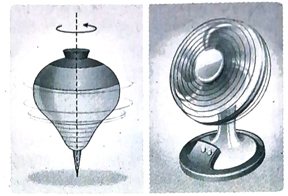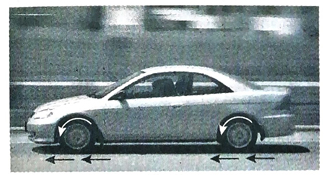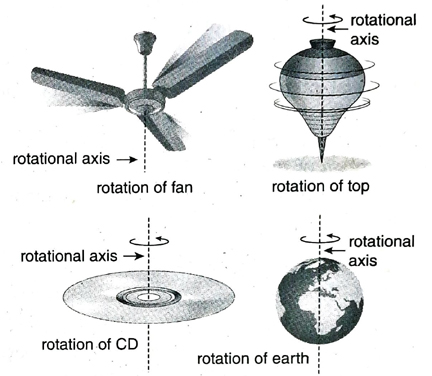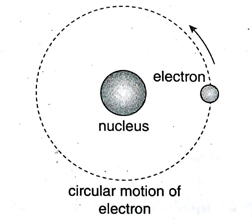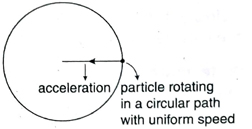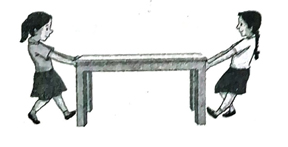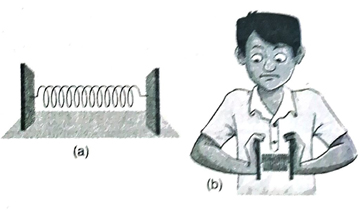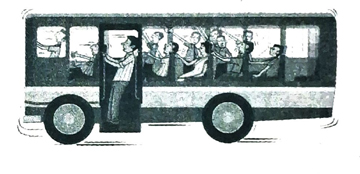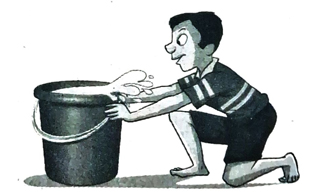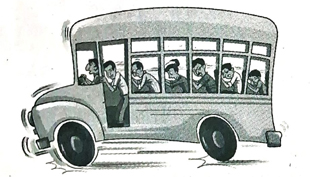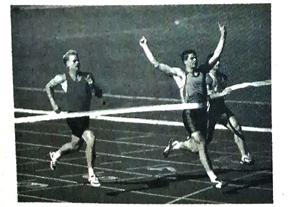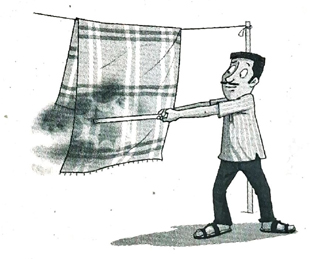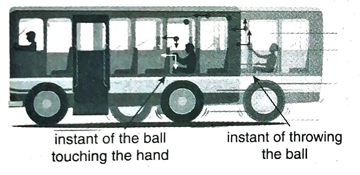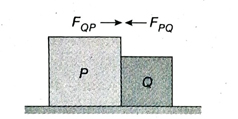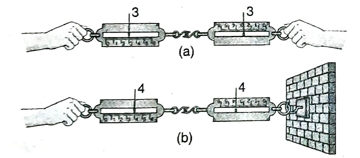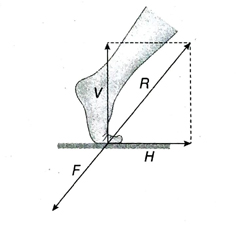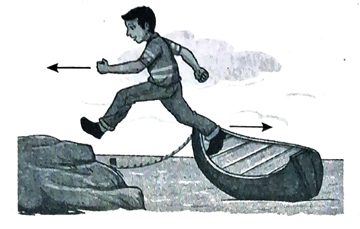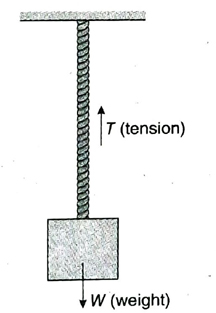WBBSE 9th Class Science Solutions Physical Science & Environment Chapter – 2 Force and Motion
West Bengal Board 9th Class Science Solutions Physical Science & Environment Chapter – 2 Force and Motion
WBBSE 9th Class Physical Science & Environment Solutions
Synopsis
- The state of rest or motion of a body is always observed with respect to some other bodies in the surrounding. This some other bodies provide the frame of reference or reference frame. There are two types of reference frame: (1) inertial frame and (2) non-inertial frame.
- If a body does not change its position with respect to a neighbouring object with change of time, then the body is said to be a static body and its state is known as state of rest.
- If a body changes its position with respect to a neighbouring object with change of time, then the body is said to be a dynamic body and its state is known as state of motion.
- If a body undergoing periodic motion moves repeatedly along the same straight line at equal intervals of time, then its motion is called rectilinear oscillatory motion.
- If a particle rotates around an axis or a point in a circular path, its motion is said to be a circular motion.
- Speed of a moving particle is the distance traversed by it in unit time. Speed is a scalar quantity. Unit of speed in Sl is m/s. Dimensional formula of speed is LT-1.
- If a moving particle traverses equal distances in equal time intervals, its corresponding speed is said to be uniform speed.
- If a moving particle traverses different distances in equal time intervals, its corresponding speed is said to be nonuniform.
- If the magnitude and direction of the velocity of a particle always remain unchanged with time, then the velocity of that particle is called uniform velocity.
- If the magnitude and direction or both of a particle change with respect to time, then the velocity of that particle is called nonuniform velocity.
TOPIC – A
Rest, Motion and Equation of Motion
SHORT AND LONG ANSWER TYPE QUESTIONS
1. What do you understand by rest and motion?
Ans. Rest: If a body does not change its position with change of time and with respect to a object, then that body is said to be a stationary body. In this condition, it is said to be at rest.
Motion: If a body changes its position with change of time and with respect to a neighbouring object, then that body is said to be a moving body. In this condition, it is said to be in motion.
2. All rest and motion are relativeexplain.
Ans. All objects like houses, trees etc. surrounding us do not change their positions with respect to the earth’s surface and also with change of time. So these are called stationary objects with respect to the surface of the earth. But the earth itself is moving around the sun. So, houses, trees etc. which are stationary, with respect to the earth are not at absolute rest. In reality, every object of this universe is in motion with respect to every other object. So, there is no state of absolute rest in nature. Since there is no existence of absolutely stationary bodies, so there is also no absolutely moving body. Thus, all rest and motion are relative.
3. How many types of motion a body may possess? What are those types?
Ans. A body may possess two types of motion.
These two types of motion are (1) rotational motion and (2) translational motion or linear motion.
4. What do you understand by rotational motion? Explain with examples.
Ans. If a body rotates with respect to one of its axes, then the motion of the body is called rotational motion.
Example: The motion of blades of a running electric fan is rotational motion. Again, the diurnal motion of the earth around its axis throughout day and night like a top is also a rotational motion.
5. What is translational motion? Explain with examples.
Ans. If a body moves in a straight line, its motion is called translational motion.
Example: If a stone is dropped from a roof top, it falls straight downward. In this case, motion of the stone is a translational motion.
6. What is compound motion? Give example.
Ans. If a body is moving in such a way that its motion is neither a pure translational motion nor a rotational motion but a mixture of both, then this motion is called a compound motion.
Example: Let us consider the motion of wheel of a running car. Except the particle at the centre point of the wheel, all other particles are undergoing compound motion.
7. What do you mean by rotational plane and axis of rotation?
Ans. Rotational Plane: When a particle rotates around a fixed axis or point, then during the state of rotation the particle makes a circle. The horizontal plane on which the circle lies is called rotational plane.
Axis of Rotation: When a particle rotates in a circular path, the straight line perpendicular to the rotational plane and passing through the centre of the circle is called the axis of rotation.
8. What is the difference between a rotational motion and a circular motion? Explain with examples.
Ans. A rigid body consists of more than one particle. When such a rigid body rotates around a fixed axis of its own, then this motion is called rotational motion. In this case, the body does not change its place with respect to its axis but simply changes its orientation. The axis about which the body rotates is called the rotational axis.
The motion of the blades of a fan is rotational motion. In this case, the blades rotate with respect to the axis situated at the centre of the fan. In the same way, the motion of a top remaining stationary at one place on the floor, motion of a disc on CD drive, diurnal motion of the earth (due to which the phenomenon of day and night occurs) etc. are examples of rotational motion.
On the other hand, the motion of a particle along a circular path is the circular motion of the particle. Since the particle has the shape of a point, hence it is not possible for the particle to have an axis. So the particle has no rotational motion.
The revolving motion of an electron around the nucleus is circular motion. Again, if the earth is considered to be a point in comparison to the sun, its motion around the sun (due to which seasonal changes occur) is the earth’s circular motion.
9. Diurnal and annual motion of the earth fall under which category?
Ans. If we assume that the earth rotates in a circular path around the sun (actually it is an elliptical path), annual motion of the earth is a circular motion. While moving around the sun, the earth rotates with respect to its own axis. This is called diurnal motion which falls under rotational motion.
10. What do you understand by periodic motion? Give examples.
Ans. If a body traverses the same path repeatedly after equal intervals of time, then the motion of the body is known as periodic motion.
Example: Diurnal motion of the earth around the sun, motion of the hand of a clock, motion of a simple pendulum etc. are examples of periodic motion.
11. What is displacement? ? What type of quantity is it?
Ans. The change of position of a moving body in a particular direction is the displacement of the body.
Displacement is a vector quantity because it has both magnitude and direction.
12. Can the displacement of a particle be greater than the traversed distance?
Ans. The displacement of a moving particle can never be greater than the traversed distance. If the particle travels from one point to another in a straight line path, the value of displacement becomes equal to that of the traversed distance but if the particle moves in a curved path, value of displacement is less than that by distance traversed.
13. What is speed? What type of quantity is speed? What are the units of speed in CGS system and SI?
Ans. The amount of distance a moving particle traverses in unit time is called its speed.
Speed has magnitude but no direction, hence it is a scalar quantity.
Units of speed in CGS system and Sl are cm/s and m/s respectively.
14. Define uniform speed and non-uniform speed.
Ans. Uniform speed: A moving particle has a uniform speed if it travels equal distances in equal intervals of time.
Non-uniform speed: A moving particle has a nonuniform speed if it travels unequal distances in equal intervals of time.
15. Define uniform velocity and nonuniform velocity.
Ans. Uniform velocity: A particle is said to have uniform velocity if it covers equal distance in equal intervals of time in a given direction.
Non-uniform velocity: A particle is said to have nonuniform velocity if the magnitude or direction or both of the particle change with respect to time.
16. Explain how a body with uniform speed Dah may not have uniform velocity.
Ans. A body is said to have uniform speed if it traverses equal distances in equal intervals of time in a curved path. As the body is moving in a curved path, the direction of its velocity changes every moment so it is not moving with uniform velocity. Hence, a body moving with uniform speed need not have uniform velocity, if it traverses equal distances in equal intervals of time by changing its direction.
17. What are uniform acceleration and nonuniform acceleration?
Ans. Uniform acceleration: A moving particle is said to have uniform acceleration if it travels in a straight line and its velocity increases equal amount in equal intervals of time.
Non-uniform acceleration: A moving particle is said to have non-uniform acceleration if its velocity increases by unequal amounts in equal intervals of time.
18. If the initial velocity of a moving particle with uniform acceleration is zero, what is the nature of the nature of its velocity-time curve?
Ans. The graph of a moving particle with uniform acceleration is always a straight line. Again, since the initial velocity of the particle is zero, hence the graph will always pass through the origin.
19. What is instantaneous acceleration?
Ans. Instantaneous acceleration is the limiting value of the ratio of the change in velocity of a moving particle during a very small change of time at any particular instant.
20. Is it possible for a moving particle to have acceleration but constant magnitude of its velocity?
Ans. If a particle moves in such a way that its acceleration always acts perpendicularly to the direction of its motion, the magnitude of velocity remains unchanged even though the moving particle has acceleration. For example, the acceleration of a particle moving in a circle with uniform speed is acting towards the centre along the radius of the circle and at any moment, velocity is acting at that point along the tangent to the circle. In this case, angle between acceleration and velocity is always 90°. So for this type of motion, magnitude of velocity always remains unchanged even though acceleration is present.
21. Deceleration is negative acceleration-explain.
Ans. If the velocity of a moving particle reduces with change of time, then the rate of change of velocity or acceleration is negative. This negative acceleration is called deceleration or retardation. In this case, deceleration and velocity act in opposite directions.
22. Why is the phrase ‘per second’ used twice in the unit of acceleration?
Ans. The word second is used twice in the unit of acceleration because it has two significances. It signifies change of velocity as well as rate of change of velocity.
23. Is it possible for a moving particle to have velocity but no acceleration?
Ans. It is possible for a particle moving with uniform velocity to have velocity but no acceleration. a particle remains stationary or moves with uniform velocity, it does not have any acceleration.
VERY SHORT ANSWER TYPE QUESTIONS
Choose the correct answer
1. A ball is thrown. What type of motion will the ball follow if rotation of the ball along its own axis is ignored?
A. compound motion
B. circular motion
C. linear motion
D. oscillatory motion in a straight line
Ans. C
2. A particle traverses a semi-circular path of 1m radius in 1s time. What is the average velocity of the particle?
A. 3.14 m/s
B. 2 m/s
C. 1 m/s
D. zero
Ans. B
3. Starting from your house, you walk 8 km in 2 hours and come back to the house. What will be your displacement?
A. 4 km
B. 2 km
C. 8 km
D. zero
Ans. D
4. n number of bullets are pumped out per second from a machine gun. If mass of each bullet is m kg and its velocity is v m/s, what is the applied force (in N unit) on this machine gun?
A. mnv
B. mn/v
C. mn
D. mv/n
Ans. A
5. An example of compound motion is
A. a ball rolling on the ground
B. rotation of a ball at one place
C. slippery motion of a ball
D. perpendicular fall of a ball from a height
Ans. A
6. A plane flies 6000 km eastward and then 8000 km northward. Then the plane comes back to its initial position by the shortest route. If the speed of this plane is 200 km/h, what was its average velocity in the total journey path?
A. 0
B. 120 km/h
C. 200 km/h
D. 220 km/h
Ans. A
7. Which of the following quantity remains unchanged in rotational motion?
A. velocity
B. axis
C. linear momentum
D. none of these
Ans. B
8. The motion of a wheel of a running car is
A. translational motion
B. rotational motion
C. compound motion
D. none of the above
Ans. C
9. Ratio of traversed distance and displacement of a moving body is
A. < 1
B. ≤ 1
C. ≥ 1
D. = 1
Ans. C
10. A man travels along the circumference of a semi-circular field of radius 14 m and goes to the other side. The magnitude of displacement of the man is
A. 44 m
B. 28 m
C. 88 m
D. 14 m
Ans. B
11. A particle moves from point A along the circumference of a circle of radius 5√2 cm to point B, so that an angle of 60° is formed at the centre. The displacement of the particle is
A. 5√2 cm
B. 5 cm
C. 10√2 cm
D. 10 cm
Ans. A
12. Initial velocity and deceleration of a particle are 20 m/s and 2.5 m/s² respectively. Time taken by the particle to come to rest is
A. 4s
B. 6s
C. 8s
D. 10s
Ans. C
13. For uniformly circular motion
A. velocity of a particle always remains unchanged
B. speed and acceleration of a particle remain unchanged
C. speed changes
D. magnitudes of speed and acceleration remain unchanged
Ans. D
14. Which of the following is at absolute rest?
A. earth
B. sun
C. moon
D. none of these
Ans. D
15. Motion of all moving bodies is
A. absolute motion
B. relative motion
C. translational motion
D. rotational motion
Ans. D
16. Example of translational motion is
A. rolling motion of a ball on ground
B. vertical fall of a ball from a height
C. rotation of a ball at one place
D. slippery motion of a ball
Ans. B
17. Direction of motion of particles inside a body which moves with translational motion in a straight line
A. always remains unchanged
B. always changes
C. may remain unchanged ormay change
D. changes at first and then remains unchanged
Ans. A
18. Direction of motion of particles inside a body which moves with oscillatory motion in a straight line
A. always remains unchanged
B. changes at an interval of time
C. always changes
D. none of the above
Ans. B
Answer in brief
1. Imagining the earth as a point with respect to sun, what type of motion does the earth undergo around the sun?
Ans. In this case, rotation of the earth is a circular motion.
2. What type of motion does a rotating body undergo around its own axis?
Ans. A rotating body undergoes a rotating motion around its own axis.
3. Two bodies of masses 5 kg and 6 kg are falling from rest without any resistance. Which one has more acceleration?
Ans. Both the bodies fall with the same acceleration (acceleration due to gravity).
4. Velocity-time (v-t) curve of a moving body is parallel to the time axis. What is the acceleration of the body?
Ans. Acceleration of the body is zero.
5. Velocity-time (v-t) curves of two moving bodies form inclined angles of 30° and 60°. Which body has more acceleration?
Ans. The curve in respect of the body with inclined angle 60° has comparatively more acceleration.
6. Is it possible for the velocity-time (v-t) curve of a body to be perpendicular to the time-axis?
Ans. No, because in that case, the curve denotes different velocities of the body at a particular time which is impossible.
7. What is the change in acceleration of a body falling freely from a height without any resistance?
Ans. No, there is no change in acceleration of the body as this is acceleration due to gravity.
8. What type of motion is the motion of wheel of a moving bicycle?
Ans. Motion of wheel of a moving bicycle is compound motion.
9. What type of motion is the motion of an arm of a clock?
Ans. Motion of an arm of a clock is rotational motion or uniform circular motion.
10. What type of motion is the motion of a freely falling body?
Ans. Motion of a freely falling body is translational motion.
11. When do the passengers of two moving trains find each other to be stationary?
Ans. When two trains move in parallel with the same velocity, passengers find them to be stationary.
12. What type of motion is the motion of a merry-go-round?
Ans. The motion of a merry-go-round is rotational motion.
13. What is circular motion?
Ans. If a particle rotates around a fixed axis or a point in a circular path, then the motion of the particle is called circular motion.
14. What is rectilinear oscillatory motion?
Ans. If a body moves repeatedly along the same straight line at equal intervals of time, then its motion is called rectilinear oscillatory motion.
15. Can the distance traversed by a moving particle be zero?
Ans. No, the distance traversed by a moving particle cannot be zero.
16. Can the displacement of a moving particle be zero?
Ans. If a particle starting from a particular point comes back to the same point, then the displacement of that particle is said to be zero.
17. When displacement of a moving particle is zero?
Ans. Displacement of a moving is zero when its initial position and final position are the same.
18. Can the ratio of distance traversed and displacement of a moving particle be less than 1?
Ans. No, the ratio of the distance travelled and the displacement of a moving particle is always 1 or more than 1.
19. When is the ratio of the distance traversed and the displacement of a moving particle equal to 1?
Ans. The ratio of the distance traversed and the displacement of a moving particle is 1 when it moves a straight line.
20. When is the ratio of the distance traversed and the displacement of a moving particle more than 1?
Ans. The ratio of the distance traversed and the displacement of a moving particle is more than 1 when it moves in a curved path.
21. What type of physical quantity is speed?
Ans. Speed is a scalar quantity because it has magnitude, but no direction.
22. A particle traverses the circumference of a circle of radius r and comes back to the position from where it started. What is its displacement?
Ans. Displacement of the particle is zero.
23. A particle traverses the circumference of a circle of radius r and comes back to the position from where it started. What is the distance covered?
Ans. Distance covered = 2πr.
24. Can the average speed of a moving particle be zero?
Ans. No, the average speed of a moving particle cannot be zero.
25. Can the average velocity of a moving particle be zero?
Ans. Yes, the average velocity of a moving particle can be zero.
26. What is negative acceleration called?
Ans. Negative acceleration is called deceleration or retardation.
27. What does the area made by a velocity-time graph with the time axis indicate?
Ans. It indicates the distance traversed.
28. What is the nature of a displacement-time graph of a particle moving with uniform velocity?
Ans. The displacement-time graph of a particle moving with uniform velocity is a straight line passing through the origin.
29. How do you define a reference body?
Ans. A reference body is a body with reference to which states of rest and motion of another body are measured.
30. What is the direction of a particle moving in a circular path at a point?
Ans. The direction of a particle moving in a circular path at a point is along the tangent to the circle at that point.
31. What does the odometer of a car indicate?
Ans. The odometer of a car indicates the instantaneous speed of the car.
32. Can the average and the instantaneous speed of a moving particle be equal at any moment?
Ans. The average speed and the instantaneous speed of a particle moving with uniform speed are equal.
33. How many times the words ‘per second’ come in the unit of acceleration?
Ans. The words ‘per second’ come twice in the unit of acceleration.
34. What does the inclined angle of a displacement-time graph indicate?
Ans. Inclined angle of a displacement-time graph indicates the instantaneous velocity.
35. What does the inclined angle of a velocitytime graph indicate?
Ans. Inclined angle of velocity-time graph indicates the instantaneous acceleration.
36. What is the nature of displacement-time graph of a particle moving with uniform acceleration?
Ans. The nature of displacement-time graph of a particle moving with uniform acceleration is parabolic.
37. What type of motion does a rotating body undergo around its own axis?
Ans. A rotating body under goes a rotational motion around its own axis.
38. What is the direction of displacement?
Ans. Direction of displacement is considered from the initial position towards the final position of a body.
Fill in the blanks
1. Average …………. of a body may be zero but its average speed need not be zero.
Ans. velocity
2. Velocity-time (v-t) curve of a moving body with uniform acceleration starting from rest passes through the ……… of the graph.
Ans. origin
3. Starting from a particular place for a journey, if one comes back to the same place, total displacement is ………….
Ans. zero
4. Speed is a …………. quantity.
Ans. scalar
5. If both the magnitude and the direction of the velocity of a particle remain unchanged with time, then velocity of that particle is called …………… velocity.
Ans. uniform
6. For a particle falling freely under gravity, constant quantity is ……………
Ans. acceleration
7. Rest and motion for a particle are ……………
Ans. relative
8. From a moving train, distant trees appear to be ……………
Ans. moving
9. For pure rotation, the axis of rotation always remains ……………
Ans. at rest
10. Diurnal motion of the earth is an example of …………… motion.
Ans. rotational
State whether true or false
1. If a body rotates around a fixed axis or a fixed point, its motion is called rotational motion.
Ans. True
2. Rate of change of velocity of a particle with respect to time is called its acceleration.
Ans. True
3. Average speed can be obtained by dividing the total displacement by the total time required to transverse the total distance.
Ans. False
4. Dimensional formula of retardation is LT-3
Ans. False
5. Passengers of two trains running side by side with the same speed in the same direction, find them mutually at rest.
Ans. True
6. Average velocity of a body will be zero when average speed of the body is zero.
Ans. False
7. If speed is zero, velocity may not be zero.
Ans. False
8. Speed may not be negative.
Ans. True
9. v-t graph of a particle moving with uniform velocity is parallel to time axis.
Ans. True
10. Free falling of a body is translational motion with constant acceleration.
Ans. True
TOPIC – B
Newton’s First and Second Laws of Motion
SHORT AND LONG ANSWER TYPE QUESTIONS
1. What is resultant force?
Ans. A resultant force is a single force obtained by combining several active forces. The important describing feature of a resultant force is that it has the same effect on the body as the original system of forces.
2. What are the effects of an applied force on a body?
Ans. By applying a force, 1. a static body may be set in motion, 2. magnitude or direction or both of a moving body may be changed, 3. a moving body may be brought to a stationary state or 4. form or shape of a body may be changed.
3. What is balanced force?
Ans. When more than one force acts on a body and the resultant of the forces is zero, then the forces are called balanced forces.
4. State Newton’s first law of motion.
Ans. Every body continues to be in its state of rest or of uniform motion in a straight line unless the body is compelled to change its state by a net external force i.e. there will be no acceleration of the object.
5. Give an examples of balanced force.
Ans. In a tug-of-war game, four boys on the left side and four boys on the right side pull the rope in such a way that the rope does not move in either direction. Here, a total of eight forces are working on the rope. But as the forces applied by the boys on the left side are equal to the forces applied by the boys on the right side and are in the opposite directions, resultant force on the rope is zero. Hence, the rope does not move in any direction. These eight forces working on the rope are called balanced forces.
6. What do you mean by effective force? Which property of the body changes due to its influence?
Ans. When resultant of the forces due to the application of one or more than one force on a body is not zero, then those forces are called effective forces. The property of motion (rest or motion) changes due to the influence of effective forces.
7. Two friends are pulling a table without being able to move it. How is it possible?
Ans. If two friends are pulling a table from two sides by applying two opposite and equal forces, then it will not move. This type of application of force means that balanced force is being applied on the table. Due to this reason, value of the resultant force on the table is zero.
8. Two friends are moving a table by pulling it with equal forces. Application of force in which direction does make this possible?
Ans. If the table is to be moved by the two friends by pulling it with equal force, the forces can never be applied opposite to each other. Applying the forces in any other direction budges the table.
9. What is the influence of effective force on a body?
Ans. Action of effective force on a body generates acceleration, i.e., change of velocity, Change of velocity may take place in different ways: 1. a static body may start moving, 2. there may be a change of velocity of a moving body, 3. there may be a change of direction of the moving body or 4. both the magnitude and the direction of the moving body may change.
10. Action of balanced force on a body creates strain-explain with example.
Ans. A spring shrinks when it is compressed with equal force by two hands. In this case, equal and opposite forces are applied on the spring by the hands. This is a balanced force. No acceleration is produced in the spring due to this. But the spring gets compressed. This compression or shrinkage of the spring is known as strain,
11. What is internal force and external internal force force?
Ans. Internal force: During application of a force on a body, if the applicator is a part of the system applying force, then the applied force cannot change the velocity of the particle but only attempts to change it. This force is called internal force.
External force: During application of a force on a body, if the applicator of the force and the body are different systems, then applied force changes the velocity of the body or attempts to change the velocity. This force is called external force.
12. Which force is responsible for change of the state of a body? Answer with the help of Newton’s first law of motion.
Ans. It is obvious from Newton’s first law of motion that it is possible to change the state of rest or state of motion of a body with the help of only external effective force. Internal force or external balanced force cannot do it.
13. Give an idea of force from Newton’s first consist law of motion.
Ans. We get a qualitative definition of force from Newton’s first law of motion. The velocity of a body does not change if any external effective force is not applied on the body. This means that there is no change in velocity of the body if it is zero (body at rest) or of any definite magnitude (with uniform velocity).
14. What are the things known from Newton’s first law of motion?
Ans. The following things are known from Newton’s first law of motion: 1. Property of inertia of matter. 2. Qualitative definition of force. 3. Change of velocity of a body is possible only by external unbalanced force and not by any internal force. 4. A clear statement that there is some sort of similarity or resemblance between the state of rest and state of motion with uniform velocity.
15. What is inertia? How many type of inertia are there and what are those?
Ans. The property of a body due to which it exists in a state of rest or of uniform motion and continues to remain in that state and opposes any attempt to change that state, is called inertia.
It is of two types, inertia of rest and inertia of motion.
16. What is inertia of rest and inertia of is inertia of rest and inertia of motion?
Ans. Inertia of rest: The tendency of a stationary body to always continue in its state of rest is called inertia of rest.
Inertia of motion: The tendency of a moving body to always continue in its state of motion with uniform velocity in a straight line is called inertia of motion.
17. A stationary bus starts moving suddenly. Why do the passengers standing inside lean in the backward direction?
Ans. When the bus is at rest, the bodies of the passengers in contact with it also remain at rest. When the bus starts moving suddenly, the lower parts of the bodies of the passengers in contact with the floor of the bus move forward while the upper parts tend to remain at rest due to inertia and the passengers lean in the backward direction.
18. what happens if a bucket full of water is suddenly pushed?
Ans. When a force is applied suddenly to a bucket full of water in the forward direction, the bucket moves forward. But water inside the bucket continues to remain at rest due to inertia of rest. So, water splashes in the backward direction.
19. If a running bus stops suddenly, passengers standing inside lean forward. Why?
Or, It is not prudent to get down from a running bus, because if one does it carelessly he may fall in all in the forward fall in the fo direction. Explain.
Ans. If a running bus with passengers stops suddenly, passengers within the bus stumble or lean in the forward direction. The reason is that when the bus was in motion, the passengers were also Imoving with the same velocity. When the bus stops by the application of brakes, lower parts of the bodies of passengers remaining in contact with the floor stop immediately. But the upper parts move forward due to inertia of motion and as a result, passengers lean forward. This is the reason why one should not get down from a running bus.
20. Why cannot the participant of a sprinting competition stop after reaching the end point?
Ans. In a sprinting competition, the goal of the competitor is to reach the end point before all.
With this goal, he does not reduce his speed even at the moment before reaching the end. Now, if he stops suddenly after reaching the end point, the upper part of his body continues to move forward due to inertia of motion. As a result, there are chances of his stumbling in the forward direction. In order to save himself from injury due to the fall, he does not stop suddenly. Rather, he gradually reduces his speed and runs for some distance before stopping.
21. When a blanket is to be dusted, why is it hung on a rope and then beaten with a stick?
Ans. To dust a blanket, it is hung on a support (say, a rope) and then beaten vigorously with a stick. The reason is that when beaten vigorously, the blanket moves in the direction of the applied force. But the dust particles attached lightly to the blanket prefer to continue in stationary state due to inertia of rest. As a result, dust particles get separated from the blanket, thereby cleaning it.
22. Is it possible for a passenger sitting inside a stationary car to move it by pushing from the inside?
Ans. No, it is not possible for a passenger sitting inside a stationary car to move it by pushing from the inside. Because a passenger sitting inside may be considered to be a part of the system. Without application of force from outside, it is not possible to move it by overcoming the frictional force between the car and the road.
23. A passenger sitting inside a bus moving on a horizontal plane with uniform velocity throws a ball upward. After some time, how does the ball come back in the hands of the passenger?
Ans. The velocities of the passenger and the ball inside the bus moving with uniform velocity are always equal to the velocity of the bus. When the ball is thrown up, an upward motion is also created along with horizontal motion. Horizontal velocity and perpendicular velocity are in perpendicular direction to each other. So, the velocities do not affect each other. This is the reason why the ball tries to maintain its inertia of motion in the horizontal direction even when it is in air. As a result, the distance traversed by the passenger in the forward direction is equal to the distance traversed by the ball in the forward direction during the same period. On the other hand, motion of the ball in the perpendicular direction is accompanied by acceleration due to gravity. So, its velocity gradually decreases to zero and then it falls downwards to reach the hands of the passenger.
24. Write down Newton’s second law of motion without introducing the concept of momentum.
Or, Write down Newton’s second law of motion in case of unchanged mass.
Ans. If the mass of a body remains unchanged, then the magnitude of external applied effective force on the body is the product of its mass and acceleration. Acceleration takes place in the direction of the applied force. This is Newton’s second law of motion without the concept of momentum or in case of unchanged mass.
25. How do you u infer that mass is an inherent property of matter?
Or, A hanging sand bag and an oscillating pendulum are displaced by the same distance. Which one requires more force to displace and why?
Ans. A sand bag requires more force for its displacement by the same distance compared to that for an oscillating pendulum. Both of them were initially at rest. Now, while producing the same amount of acceleration in them by application of force, both the bodies oppose the forces due to their properties of inertia. This property of inertia of a body is measured by its mass. Since the mass of the sand bag is many times greater than the mass of the oscillating pendulum, hence more force is required in this case.
VERY SHORT ANSWER TYPE QUESTIONS
Choose the correct answer
1. Which law of motion of Newton defines force qualitatively?
A. First law of motion
B. Second law of motion
C. Third law of motion
D. Law of gravitation
Ans. A
2. An example of inertia of rest is
A. dusting of a blanket by a stick
B. fixing of a nail by a hammer
C. recoiling of a gun after firing of a bullet
D. circling of a fan after switching off
Ans. A
3. When a force of 75 N acts on a body to produce an acceleration of 3 m . s-², mass of the body is
A. 20 kg
B. 30 kg
C. 35 kg
D. 25 kg
Ans. D
4. An iron ball rolls and strikes another ball. This is an example of a force called
A. frictional force
B. colliding force
C. normal force
D. tension force
Ans. B
5. A book which is pushed on the table, goes some distance and stops. The book stops due to a force called
A. frictional force
B. colliding force
C. normal force
D. tension force
Ans. A
6. Which of the following is an example of normal force?
A. A stone is attached to one end of a rope and is hung from hand
B. A man is standing on the floor
C. An iron nail is moving towards a magnet
D. A man stumbles forward while getting down from a car
Ans. B
7. A body is moving with constant speed. Force is not required in which of the following cases?
A. to reduce speed of the body
B. to increase speed of the body
C. to change the direction of velocity of the body
D. to keep the direction of velocity of the body same
Ans. D
8. A motor-driven belt is in motion with a uniform velocity of 8 m/s. If sand is poured on the belt at the rate of 2 kg/s, then how much force does the motor apply to keep the same motion?
A. 8 N
B. 12 N
C. 32 N
D. 16 N
Ans. D
9. The value of a force which has two rectangular components of 15 N and 8N is
A. 17 N
B. 23 N
C. 20 N
D. 46 N
Ans. A
10. A particle moving with uniform acceleration has an initial velocity of 10 m/s and a final velocity of 20 m/s. Velocity of the particle when it finishes half the total journey time is
A. 15 m/s
B. 18 m/s
C. 12 m/s
D. 16 m/s
Ans. A
11. Starting from rest, a particle traversed a certain distance in 100s with uniform acceleration. How much time does it take to traverse half the distance?
A. 50 s
B. 70 s
C. 70.7 s
D. 71 s
Ans. C
12. A bullet loses half of its velocity after entering cm in a wooden block. The distance that the bullet goes further before coming to rest is
A. 3 cm
B. 2 cm
C. 1.5 cm
D. 1 cm
Ans. B
13. A bullet moving with a velocity of 100 m/s can penetrate a 1 cm thick wooden plank. The velocity required by the bullet to penetrate a plank having a thickness of 16 cm is
A. 200 m/s
B. 400 m/s
C. 800 m/s
D. 150 m/s
Ans. B
14. In inertial frame of reference
A. only Newton’s first law of motion is valid
B. only Newton’s second law is valid
C. only Newton’s third law is valid
D. all the laws of motion are valid
Ans. D
Answer in brief
1. What is the shape of the path of a particle when it is in uniform motion?
Ans. The shape of the path of a particle when it is in uniform motion is straight line.
2. What is the change in total linear momentum of two bodies due to their collision?
Ans. In this case, if there is no applied force from the outside, the total linear momentum of the two bodies does not change.
3. Two friends are displacing a table by application of unequal forces. Application of force in which direction does make this possible?
Ans. When two friends displace the table by application of unequal forces, then application of force in any direction makes this possible.
4. Under the influence of which force on a mass at rest, no acceleration is generated?
Ans. No acceleration is generated on a mass at rest under the influence of balanced force.
5. Under the influence of which force on a mass at rest, acceleration is generated?
Ans. Acceleration is generated on a mass at rest under the influence of effective force.
6. Strain of a body is produced under the influence of which force?
Ans. Strain of a body is produced under the influence of balanced force.
7. Which force can change the state of rest or state of motion of a body?
Ans. External effective force can change the state of rest or the state of motion of a body.
8. Write down Newton’s first law of motion.
Ans. Every body continues to be in its state of rest or uniform motion in a straight line, unless an external force is applied to it.
9. What are the forces active on a body?
Ans. Two types of forces can be active on a body These are:
(1) internal forces and (2) external forces.
10. Which law of motion of Newton gives a qualitative definition of force?
Ans. Newton’s first law of motion gives a qualitative definition of force.
11. A bucket full of water is suddenly pushed. State whether the water splashes forward or backward.
Ans. If a bucket full of water is suddenly pushed, water splashes backward.
12. Why do the blades of a rotating electric fan continue to rotate for some time even after switching it off?
Ans. Due to inertia of motion, the blades of a rotating electric fan rotates for a couple of times before it comes to rest.
13. Which law of motion of Newton gives a quantitative definition of force?
Ans. Newton’s second law of motion gives a quantitative definition of force.
14. What is the relationship between newton and dyne?
Ans. 1 N = 105 dyn
15. What is the dimensional formula of linear momentum?
Ans. Dimensional formula of linear momentum is MLT-1.
16. Which one is more convenient-pushing a roller or pulling a roller?
Ans. Pulling a roller is more convenient than pushing it:
17. What is attraction?
Ans. If two bodies come nearer to each other due to action-reaction, then that is called attraction.
18. What do you understand by resolution of a force into two components?
Ans. A force is said to be resolved into two components in two given directions such that the resultant of these two components is equal to the applied force.
Fill in the blanks
1. In spite of application of a ………… force on a moving body of fixed mass, it may move with uniform velocity.
Ans. balanced
2. In case of addition of …………. quantities, law of parallelogram is applied.
Ans. vector
3. The two resolved parts of any force are the two …………… of that force.
Ans. components
4. Any body at ……….. cannot move on its own and any …………. body can not stop on its own.
Ans. rest, moving
5. Mass is the ………….. property of a body.
Ans. inherent
6. Mass is the measure of ……………. of a body.
Ans. inertia
7. 1 N= …………. dyn.
Ans. 105
8. The total linear momentum of a system of bodies is conserved if the total external force is …………
Ans. zero
9. Dimensional formula of force is ……………..
Ans. MLT-2
10. An electric fan rotates due to …………. even after the current is switched off.
Ans. inertia of motion
State whether true or false
1. If more than one force acts on a body such that the resultant of the forces is non-zero, then the forces are called balanced forces.
Ans. False
2. Variable mass system is a system whose mass remains constant during its state of motion.
Ans. False
3. The ratio of the force applied on a body and the acceleration of the body is called its inertial mass.
Ans. True
4. Dimensional formula of linear momentum is MLT-2.
Ans. False
5. Newton’s second law of motion states that to every action, there is an equal and opposite reaction.
Ans. False
6. The tendency of a stationary body to continue to exist in its state of rest is called inertia of rest.
Ans. True
7. Amount of force can be calculated from Newton’s second law of motion.
Ans. True
8. Inertia of a body increases with the increase of acceleration of the body.
Ans. False
9. Amount of force required to stop a body depends on the momentum of the body.
Ans. True
10. Force is necessary to maintain the uniform velocity of a moving object having variable mass.
Ans. True
TOPIC – C
Newton’s Third Law of Motion and Law of Conservation of Linear Momentum
SHORT AND LONG ANSWER TYPE QUESTIONS
1. Write down Newton’s third law of motion and explain it.
Ans. To every action, there is an equal and opposite reaction.
Suppose, block P in a moving state applies a force Fap on the block Q. At the same time, block Q also applies a force Fpo on block P.
If force Fop is action, then Fpo is reaction. According to Newton’s third law of motion,
FQP = –FPQ
As long as action exists, reaction also continues to exist. If there is no action, there is also no reaction. This means that action and reaction take place simultaneously, it never happens that one occurs earlier and the other occurs later.
2. With the help of an experiment, show that action and reaction are equal and opposite.
Ans. Two spring balances are taken. Hook of one balance is attached to the hook of the other. Now the remaining two ends of the balances are pulled by two hands in such a way that there is no displacement of the two spring balances. It is seen that the reading shown by the left spring balance is equal to the reading shown by the right spring balance [Fig. (a)]. Now, the right spring balance is fixed with the wall and the end of the left spring balance is pulled. In this case also, the reading of the left spring balance is the same as the reading of the right spring balance [Fig. (b)].
In the first case, if the force of the left hand is designated as action, then the force of the right hand is reaction. In the second case also, the force applied on the spring is action, then the force applied by the wall is reaction. Hence, it is found that action and reaction are equal and opposite.
3. Opposite poles of two magnets attract each other-explain this phenomenon with the help of Newton’s third law of motion.
Ans. If the north pole of a bar magnet is brought near the south pole of another bar magnet, it is seen that the two magnets move towards each other, that is, the two poles attract each other [Fig. ]. If the magnet on the left side attracts the magnet on the right side with force F1 and the magnet on the right side attracts the magnet on the left side with force F2, then F1 = -F2:
Therefore, if force F1 is called action, then F2 is the reaction. Since action and reaction are equal and opposite, hence this type of attraction is called mutual attraction force.
4. When a shell is fired from a cannon, the cannon recoils. Explain this phenomenon with the help of Newton’s third law of motion.
Ans. When a shell is fired from a cannon, the shell moves forward with high velocity and the cannon recoils immediately. The force applied by the cannon on the shell is taken as action, then the shell moves forward due to this action. The equal and opposite reaction exerted by the shell on the cannon causes the cannon to recoil.
5. Give a scientific explanation of our walking with the help of Newton’s third law of motion.
Ans. When we walk, we obliquely exert a force (F) on the ground. The ground also exerts an equal reaction (R) on us in the opposite direction. The horizontal component of this reaction force (H) helps us to move forward.
6. Why is a boat pushed backward, if a passenger jumps from it towards the shore?
Ans. When a passenger jumps from a boat, he applies a force on the boat with his legs. Due to the influence of this force, the boat moves backward. At the same moment, the boat also applies a reaction force of equal magnitude, opposite to the direction of force applied by the passenger. This force helps the passenger to reach the shore.
7. Though action and reaction forces are equal and work in opposite directions, why cannot they establish equilibrium?
Ans. Two equal and opposite forces applied on a body with the same line of action, keep the body in equilibrium. But though action and reaction are equal and in opposite directions, they always act on two different bodies. Hence, action and reaction forces cannot establish equilibrium.
8. What do you mean by tension of a rope?
Ans. One end of a rope is firmly fixed and the other end is hanged with a wooden block attached to it [Fig.]. The weight (W) of the block is acting downward in a perpendicular direction, so the block applies a force of equal amount of its weight on the rope which acts downward. The rope also applies a force on the block equal to the weight of the body, acting in an opposite direction. This force is called tension of a rope.
9. According to the third law of motion, if a person pushes a book, then the book also pushes the person in the opposite direction. In which direction does the book move?
Ans. As the person pushes the book, then according to Newton’s third law of motion, the book also pushes the person in the opposite direction with equal magnitude of force. The force applied by the person is action force whereas the force applied by the book is reaction force. Action and reaction are always of equal magnitude working in opposite directions but they always act on separate bodies. That is why they cannot establish equilibrium. So the book moves in the direction of the force applied by the person. But the amount of force applied should be greater than the frictional force applied by the book to put it in motion.
10. What do you mean by attraction and repulsion?
Ans. If the opposite poles of two rod magnets are brought nearby, it is seen that due to mutual action-reaction, they come close to each other. This type of force is called attraction. Again, if the like poles of these two rod magnets are brought nearby, it is seen that due to mutual actionction, they recede away. type of force is called repulsion. This means if two bodies come nearby due to mutual action-reaction, then that force is called attraction and if two bodies move away from each other, then that force is called repulsion.
VERY SHORT ANSWER TYPE QUESTIONS
Choose the correct answer
1. The basis of working principle of a jet engine is
A. principle of conservation of mass
B. principle of conservation of energy
C. principle of conservation of linear momentum
D. principle of conservation of angular momentum
Ans. C
2. The motion of a rocket is established on the principle of conservation of
A. energy
B. kinetic energy
C. linear momentum
D. mass
Ans. C
3. Action and reaction
A. are applied on the same body
B. are applied on different bodies
C. are equal and unidirectional
D. are in opposite directions but their values are not equal
Ans. B
4. A gun recoils if a bullet is fired from it
A. according to Newton’s second law of motion
B. according to Newton’s first law of motion
C. due to reaction force
D. due to action force
Ans. C
5. The principle of conservation of linear momentum states that the linear momentum of a system
A. can not be changed
B. can not remain constant
C. can be changed only if internal forces act
D. can be changed only if external forces acts
Ans. D
6. A boy of mass 40 kg jumps from a boat of mass 200 kg at a velocity 10 m/s. What is the velocity of the boat?
A. 2 m/s
B. 1 m/s
C. 4 m/s
D. 5 m/s
Ans. A
7. A nucleus disintegrates into two nuclear parts which have their velocities in the ratio 3:2. The ratio of their mass will be
A. 3:2
B. 2:3
C. 9:4
D. 4:9
Ans. B
8. The difference between the nature of a rocket and a jet is
A. rockets can only move in air but jets can not
B. rockets can move out side the atmosphere but jets can not
C. rockets obtain oxygen from air but jets carries its own oxygen
D. both of them carries own oxygen
Ans. B
9. If 10 N force acts on a body, then reaction force will be
A. 10 N along the direction applied force
B. 20 N along the direction of applied force
C. 10 N opposite to the direction of the applied force
D. 20 N opposite to the direction of the applied force
Ans. C
10. Conservation of linear momentum is applicable when external force will be
A. very small in magnitude
B. zero
C. very large in magnitude
D. constant in magnitude
Ans. B
11. An iron ball collides with another iron ball at rest. Here the force comes into play is
A. friction force
B. normal reaction force
C. tension force
D. collision force
Ans. D
12. When a book lying on a table is pushed, it moves some distance and then stops. The external force which affects the motion of the body is
A. collision force
B. tension
C. friction
D. normal reaction
Ans. C
13. According to Newton’s third law of motion, the angle between action force and its reaction force
A. 0°
B. 180°
C. 90°
D. 360°
Ans. B
14. Which is not a contact force?
A. friction
B. gravitational force
C. tensile force
D. collision force
Ans. B
15. Recoil velocity of a gun
A. less than the velocity of the bullet
B. grater then the velocity of the bullet
C. equal to the velocity of the bullet
D. A and B
Ans. A
Answer in brief
1. What is the force due to which it is difficult to push a body on the ground?
Ans. It is difficult to push a body on the ground due to the force of friction between the ground and the body.
2. “Action-reaction can establish equilibrium” -is the statements, true or false?
Ans. The statement is false.
3. The working principle of a rocket depends on which basic principle?
Ans. The working principle of a rocket depends on the principle of conservation of linear momentum.
4. What is repulsion?
Ans. Due to action-reaction, if two bodies move away from each other, then it is called repulsion.
5. Write down the law of conservation of linear momentum.
Ans. The law states that if no external force is applied, the total linear momentum of a body or system of bodies always remains unchanged.
6. What do you mean by friction?
Ans. When a body moves or tends to move on another body or on any surface, then the acts opposing force that against this movement or tendency of movement is called friction.
7. What change in total linear momentum does occur in the case of collision between two bodies?
Ans. If no external force is applied total linear momentum of the system will remain unchanged.
8. Give one example of contact force.
Ans. Force of friction or simply friction is an example of contact force.
9. Why it is difficult to move a body over the earth’s surface?
Ans. Due to the arise of frictional force it is difficult to move a body over the earth’s surface.
10. Give one example of a non contact force.
Ans. Gravitational force of attraction is an example of non contact force.
11. What do you mean by friction?
Ans. When a body moves or tends to move on another body or any surface, then the opposing force that acts against this movement or tendency of movement is called friction.
12. Why do not the forces of action and reaction cancel each other?
Ans. Action and reaction forces act on different bodies that is why they do not cancel each other.
13. Name the principle on which a rocket works.
Ans. Conservation of linear momentum is the principle on which a rocket works.
14. A bucket full of water is suddenly pushed. State whether the water splashes forward or backward?
Ans. Water splashes backward.
Fill in the blanks
1. Every action has an …………….. and opposite …………..
Ans. equal, reaction
2. Rocket propulsion is possible even in an ………… place.
Ans. air-free
3. Action-reaction cannot …………. mutually.
Ans. balance
4. The theory of flight of a jet plane can be explained by Newton’s ………… law of motion.
Ans. third
5. Action and reaction forces acts on …………. bodies.
Ans. different
6. If a body A slips over another body B the force comes into play that resist this motion is called ………..
Ans. friction
7. The linear momentum of a system remains constant if no …………. force acts on it.
Ans. external
8. Normal reaction force is a ………….. force.
Ans. contact
9. Magnetic force is an example of ………… force.
Ans. non-contact
State whether true or false
1. The total linear momentum of a system of bodies can be changed without the application of an external force.
Ans. False
2. A spring can pull an object as well as push an object.
Ans. True
3. A ball moving on a horizontal surface stops because of the force of friction.
Ans. True
4. Any pair of equal and opposite forces forms an action-reaction pair.
Ans. False
5. Magnetic force is contact force.
Ans. True
6. Birds can fly in air-free space.
Ans. False
7. If the magnitude of action force be 15 N then the magnitude of the reaction force will be 15 N.
Ans. True
8. A boat is floating on still water. A man walks from one end of the boat moves backwards.
Ans. True

